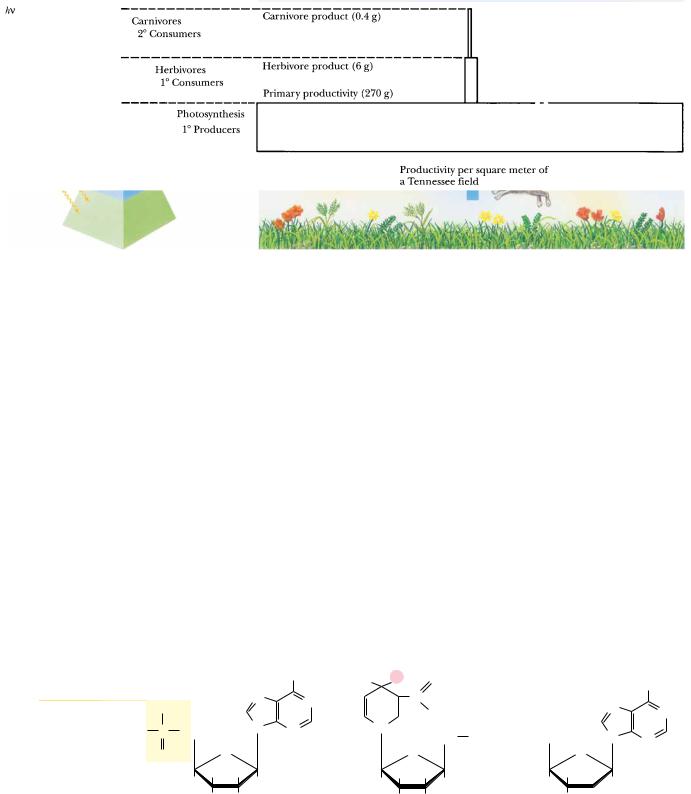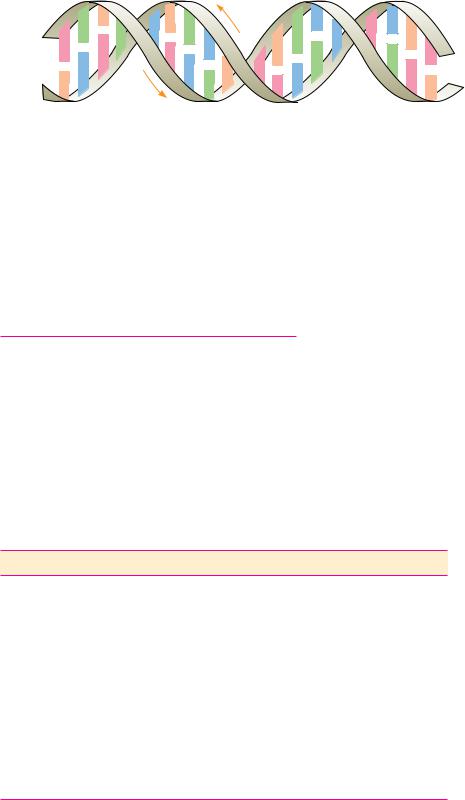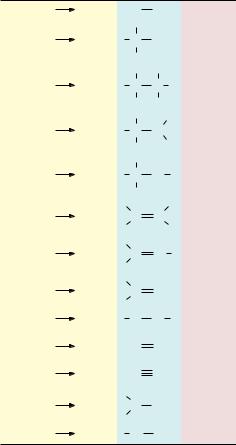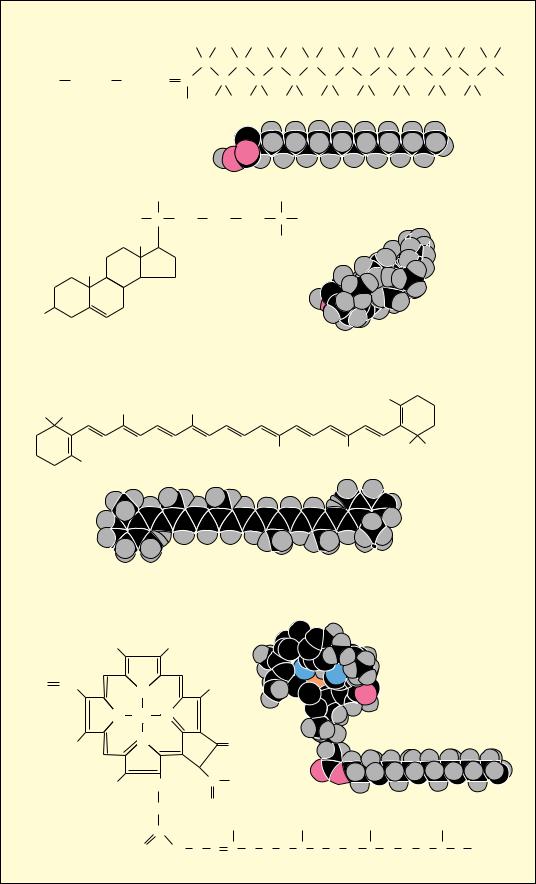
Garrett R.H., Grisham C.M. - Biochemistry (1999)(2nd ed.)(en)
.pdf
Part I
Molecular Components
of Cells
All life depends on water; all organisms are aqueous chemical systems. (Waves in Oahu,
Hawaii, Brad Lewis/Liaison International)
CHAPTER 1
Chemistry Is the Logic of
Biological Phenomena
CHAPTER 2
Water, pH, and Ionic Equilibria
CHAPTER 3
Thermodynamics of
Biological Systems
CHAPTER 4
Amino Acids
CHAPTER 5
Proteins: Their Biological Functions
and Primary Structure
APPENDIX TO CHAPTER 5
Protein Techniques
CHAPTER 6
Proteins: Secondary, Tertiary, and
Quaternary Structure
CHAPTER 7
Carbohydrates
CHAPTER 8
Lipids
CHAPTER 9
Membranes and Cell Surfaces
CHAPTER 10
Membrane Transport
CHAPTER 11
Nucleotides
CHAPTER 12
Nucleic Acids
CHAPTER 13
Recombinant DNA

“ . . . everything that living things do can be understood in terms of the jigglings and wigglings of atoms.”
RICHARD P. FEYNMAN
Lectures on Physics
Addison-Wesley Publishing Company, 1963
OUTLINE
1.1 ● Distinctive Properties of Living Systems
1.2 ● Biomolecules: The Molecules of Life
1.3 ● A Biomolecular Hierarchy: Simple
Molecules Are the Units for Building
Complex Structures
1.4 ● Properties of Biomolecules Reflect Their Fitness to the Living Condition
1.5 ● Organization and Structure of Cells
1.6 ● Viruses Are Supramolecular Assemblies
Acting as Cell Parasites
2
Chapter 1
Chemistry Is the Logic of
Biological Phenomena
“Swamp Animals and Birds on the River Gambia,” c. 1912 by Harry Hamilton Johnston (1858–1927). (Royal Geographical Society, London/The
Bridgeman Art Library.)
Molecules are lifeless. Yet, in appropriate complexity and number, molecules compose living things. These living systems are distinct from the inanimate world because they have certain extraordinary properties. They can grow, move, perform the incredible chemistry of metabolism, respond to stimuli from the environment, and, most significantly, replicate themselves with exceptional fidelity. The complex structure and behavior of living organisms veil the basic truth that their molecular constitution can be described and understood. The chemistry of the living cell resembles the chemistry of organic reactions.

Indeed, cellular constituents or biomolecules must conform to the chemical and physical principles that govern all matter. Despite the spectacular diversity of life, the intricacy of biological structures, and the complexity of vital mechanisms, life functions are ultimately interpretable in chemical terms. Chemistry is the logic of biological phenomena.
1.1 ● Distinctive Properties of Living Systems
1.1 ● Distinctive Properties of Living Systems |
3 |
logic ● a system of reasoning, using principles of valid inference
The most obvious quality of living organisms is that they are complicated and highly organized (Figure 1.1). For example, organisms large enough to be seen with the naked eye are composed of many cells, typically of many types. In turn, these cells possess subcellular structures or organelles, which are complex assemblies of very large polymeric molecules or macromolecules. These macromolecules themselves show an exquisite degree of organization in their intricate three-dimensional architecture, even though they are composed of simple sets of chemical building blocks, such as sugars and amino acids. Indeed, the complex three-dimensional structure of a macromolecule, known as its conformation, is a consequence of interactions between the monomeric units, according to their individual chemical properties.
Biological structures serve functional purposes. That is, biological structures have a role in terms of the organism’s existence. From parts of organisms, such as limbs and organs, down to the chemical agents of metabolism, such as enzymes and metabolic intermediates, a biological purpose can be given for each component. Indeed, it is this functional characteristic of biological structures that separates the science of biology from studies of the inanimate world such as chemistry, physics, and geology. In biology, it is always meaningful to seek the purpose of observed structures, organizations, or patterns, that is, to ask what functional role they serve within the organism.
Living systems are actively engaged in energy transformations. The maintenance of the highly organized structure and activity of living systems depends upon their ability to extract energy from the environment. The ultimate source of energy is the sun. Solar energy flows from photosynthetic organisms (those organisms able to capture light energy by the process of photosynthesis) through
(a) |
(b) |
FIGURE 1.1 ● |
(a) Mandrill (Mandrillus sphinx), a baboon native to West Africa. |
(b) Tropical orchid (Bulbophyllum blumei), New Guinea. (a, Tony Angermayer/Photo Researchers, Inc.; b, Thomas C. Boydon/Marie Selby Botanical Gardens)

4 Chapter 1
● The food pyramid. Photosynthetic organisms at the base capture light energy. Herbivores and carnivores derive their energy ultimately from these primary producers.
food chains to herbivores and ultimately to carnivorous predators at the apex of the food pyramid (Figure 1.2). The biosphere is thus a system through which energy flows. Organisms capture some of this energy, be it from photosynthesis or the metabolism of food, by forming special energized biomolecules, of which ATP and NADPH are the two most prominent examples (Figure 1.3). (Commonly used abbreviations such as ATP and NADPH are defined on the inside back cover of this book.) ATP and NADPH are energized biomolecules because they represent chemically useful forms of stored energy. We explore the chemical basis of this stored energy in subsequent chapters. For now, suffice it to say that when these molecules react with other molecules in the cell, the energy released can be used to drive unfavorable processes. That is, ATP, NADPH, and related compounds are the power sources that drive the energyrequiring activities of the cell, including biosynthesis, movement, osmotic work against concentration gradients, and, in special instances, light emission (bioluminescence). Only upon death does an organism reach equilibrium with its inanimate environment. The living state is characterized by the flow of energy through the organism. At the expense of this energy flow, the organism can maintain its
|
|
|
|
|
|
|
|
|
|
|
|
NH2 |
|
|
|
|
|
|
|
|
|
|
|
|
N |
|
N |
|
|
|
|
|
|
|
|
|
|
|
|
||
–O |
|
O– |
|
O– |
O– |
|
N |
|
|||||
|
|
|
|
|
|
|
|
|
|
N |
|||
|
P |
|
O |
|
P |
|
O |
P OCH2 |
|||||
|
|
|
|
O |
|||||||||
|
|
|
|
|
|
|
|
|
|
|
|
|
|
|
|
O |
|
O |
O |
|
|
||||||
|
|
|
|
|
|
||||||||
|
|
|
|
|
|
|
|
|
|
H |
H |
|
|
|
|
|
|
|
|
|
|
|
|
H |
H |
|
|
|
|
|
|
|
|
|
|
|
|
OH OH |
|
|
|
ATP
H H |
O |
|
|
|
|
|
|
|
|
|
|
|
|
|
|
|
NH2 |
||
|
|
C |
|
|
|
|
|
|
|
|
|
|
|
|
|
|
|
||
|
|
O– |
|
|
|
O– |
|
|
N |
|
N |
||||||||
|
|
NH2 |
|
|
|
|
|
|
|||||||||||
N |
|
|
|
OCH2 |
N |
|
|||||||||||||
H2CO |
|
|
|
|
|
|
|
|
|
|
|
||||||||
P |
|
|
O |
|
P |
|
N |
||||||||||||
|
|
|
|
|
|
||||||||||||||
|
|
|
|
|
|
||||||||||||||
|
|
O |
|
|
|
|
|
|
|
|
|
O |
|
|
|
|
|
|
|
|
|
O |
|
|
|
O |
|
|
|
|
|
|
|||||||
H |
H |
|
|
|
H H |
|
|
|
|
|
|
||||||||
|
|
|
|
|
|
|
|
|
|
|
|
|
|
|
|||||
H |
H |
|
|
|
|
|
|
|
|
|
H |
|
H |
|
|
||||
OH OH |
|
|
|
|
|
|
|
|
|
OH |
|
|
O |
|
|
||||
|
|
|
|
|
|
NADPH |
|
|
|
|
|
|
O– |
||||||
|
|
|
|
|
|
O |
|
P |
|
||||||||||
|
|
|
|
|
|
|
|
||||||||||||
|
|
|
|
|
|
|
|
|
|
|
|
|
|
|
|
|
|
|
|
|
|
|
|
|
|
|
|
|
|
|
|
|
|
|
O– |
|
|
||
FIGURE 1.3 ● ATP and NADPH, two biochemically important energy-rich compounds.

1.1 ● Distinctive Properties of Living Systems |
5 |
intricate order and activity far removed from equilibrium with its surroundings, yet exist in a state of apparent constancy over time. This state of apparent constancy, or so-called steady-state, is actually a very dynamic condition: energy and material are consumed by the organism and used to maintain its stability and order. In contrast, inanimate matter, as exemplified by the universe in totality, is moving to a condition of increasing disorder or, in thermodynamic terms, maximum entropy.
Living systems have a remarkable capacity for self-replication. Generation after generation, organisms reproduce virtually identical copies of themselves. This self-replication can proceed by a variety of mechanisms, ranging from simple division in bacteria to sexual reproduction in plants and animals, but in every case, it is characterized by an astounding degree of fidelity (Figure 1.4). Indeed, if the accuracy of self-replication were significantly greater, the evolution of organisms would be hampered. This is so because evolution depends upon natural selection operating on individual organisms that vary slightly in their fitness for the environment. The fidelity of self-replication resides ultimately in the chemical nature of the genetic material. This substance consists of polymeric chains of deoxyribonucleic acid, or DNA, which are structurally complementary to one another (Figure 1.5). These molecules can generate new copies of themselves in a rigorously executed polymerization process that ensures a faithful reproduction of the original DNA strands. In contrast, the
(a) |
(b) |
|
FIGURE 1.4 ● Organisms resemble their parents. (a) Reg Garrett with sons Robert, Jeffrey, Randal, and grandson Jackson. (b) Orangutan with infant. (c) The Grishams: Andrew, Rosemary, Charles, Emily, and David. (a, William
W. Garrett, II; b, Randal Harrison Garrett; c, Charles Y. Sipe)
(c)

6 Chapter 1 ● Chemistry Is the Logic of Biological Phenomena
complementary ● completing, making whole or perfect by combining or filling a deficiency
|
|
A |
A |
|
|
G |
|
|
|
5' |
T |
G |
|
|
|
|
T |
C |
|
T |
C |
|
||
|
C |
|||
A |
|
|
|
G |
3' |
|
C |
C |
|
|
|
G |
G |
G |
A |
T |
|
A |
|
|
T |
5' |
|
C |
|
|
|
A |
|
T |
|
|
|
3' |
● The DNA double helix. Two complementary polynucleotide chains running in opposite directions can pair through hydrogen bonding between their nitrogenous bases. Their complementary nucleotide sequences give rise to structural complementarity.
molecules of the inanimate world lack this capacity to replicate. A crude mechanism of replication, or specification of unique chemical structure according to some blueprint, must have existed at life’s origin. This primordial system no doubt shared the property of structural complementarity (see later section) with the highly evolved patterns of replication prevailing today.
1.2 ● Biomolecules: The Molecules of Life
The elemental composition of living matter differs markedly from the relative abundance of elements in the earth’s crust (Table 1.1). Hydrogen, oxygen, carbon, and nitrogen constitute more than 99% of the atoms in the human body, with most of the H and O occurring as H2O. Oxygen, silicon, aluminum, and iron are the most abundant atoms in the earth’s crust, with hydrogen, carbon, and nitrogen being relatively rare (less than 0.2% each). Nitrogen as dinitrogen (N2) is the predominant gas in the atmosphere, and carbon dioxide (CO2) is present at a level of 0.05%, a small but critical amount. Oxygen is also abundant in the atmosphere and in the oceans. What property unites H, O, C, and
Table 1.1
Composition of the Earth’s Crust, Seawater, and the Human Body*
Earth’s Crust |
Seawater |
|
|
Human Body† |
|||
|
|
|
|
|
|
|
|
Element |
% |
|
Compound |
mM |
Element |
% |
|
|
|
|
|
|
|
|
|
O |
47 |
|
Cl |
548 |
|
H |
63 |
Si |
28 |
|
Na |
470 |
|
O |
25.5 |
Al |
7.9 |
|
Mg2 |
54 |
|
C |
9.5 |
Fe |
4.5 |
|
SO42 |
28 |
|
N |
1.4 |
Ca |
3.5 |
|
Ca2 |
10 |
|
Ca |
0.31 |
Na |
2.5 |
|
K |
10 |
|
P |
0.22 |
K |
2.5 |
|
HCO3 |
2.3 |
|
Cl |
0.08 |
Mg |
2.2 |
|
NO3 |
0.01 |
|
K |
0.06 |
Ti |
0.46 |
HPO42 |
0.001 |
S |
0.05 |
||
H |
0.22 |
|
|
|
Na |
0.03 |
|
C |
0.19 |
|
|
|
Mg |
0.01 |
|
*Figures for the earth’s crust and the human body are presented as percentages of the total number of atoms; seawater data are millimoles per liter. Figures for the earth’s crust do not include water, whereas figures for the human body do.
†Trace elements found in the human body serving essential biological functions include Mn, Fe, Co, Cu, Zn, Mo, I, Ni, and Se.

1.2 ● Biomolecules: The Molecules of Life |
7 |
N and renders these atoms so suitable to the chemistry of life? It is their ability to form covalent bonds by electron-pair sharing. Furthermore, H, C, N, and O are among the lightest elements of the periodic table capable of forming such bonds (Figure 1.6). Because the strength of covalent bonds is inversely proportional to the atomic weights of the atoms involved, H, C, N, and O form the strongest covalent bonds. Two other covalent bond-forming elements, phosphorus (as phosphate OOPO32 derivatives) and sulfur, also play important roles in biomolecules.
Biomolecules Are Carbon Compounds
All biomolecules contain carbon. The prevalence of C is due to its unparalleled versatility in forming stable covalent bonds by electron-pair sharing. Carbon can form as many as four such bonds by sharing each of the four electrons in its outer shell with electrons contributed by other atoms. Atoms commonly found in covalent linkage to C are C itself, H, O, and N. Hydrogen can form one such bond by contributing its single electron to formation of an electron pair. Oxygen, with two unpaired electrons in its outer shell, can participate in two covalent bonds, and nitrogen, which has three unshared electrons, can form three such covalent bonds. Furthermore, C, N, and O can share two electron pairs to form double bonds with one another within biomolecules, a property that enhances their chemical versatility. Carbon and nitrogen can even share three electron pairs to form triple bonds.
|
|
|
|
|
|
Bond |
|
|
e– pairing |
Covalent |
energy |
||
Atoms |
bond |
(kJ/mol) |
||||
H + H |
H H |
H |
H |
436 |
||
C |
+ H |
C |
H |
C |
H |
414 |
C |
+ C |
C |
C |
C |
C |
343 |
C |
+ N |
C |
N |
C |
N |
292 |
C |
+ O |
C |
O |
C |
O |
351 |
C |
+ C |
C |
C |
C |
C |
615 |
C |
+ N |
C |
N |
C |
N |
615 |
C |
+ O |
C |
O |
C |
O |
686 |
O + O |
O O |
O |
O |
142 |
||
O + O |
O |
O |
O |
O |
402 |
|
N + N |
N |
N |
N |
N |
946 |
|
N + H |
N H |
N |
H |
393 |
||
O + H |
O H |
O |
H |
460 |
||
FIGURE 1.6 ● Covalent bond formation by e pair sharing.

8 Chapter 1 ● Chemistry Is the Logic of Biological Phenomena
● Examples of the versatility of COC bonds in building complex structures: linear aliphatic, cyclic, branched, and planar.
LINEAR ALIPHATIC: |
|
H H H H H H H H H H H H H H H H H H |
|||||||||||||
Stearic acid |
|
|
|
||||||||||||
|
|
|
|
|
|
|
|
|
|
|
|
|
|
||
|
|
|
|
|
C |
C |
C |
C |
C |
C |
C |
|
C |
C |
|
HOOC |
(CH2)16 |
|
CH3 |
O |
C |
C |
C |
C |
|
C |
C |
C |
C |
C |
H |
|
|
|
|
HO |
H H H H H H H H H H H H H H H H |
||||||||||
|
|
|
|
|
|
|
|
|
|
|
|
|
|
||
CYCLIC: |
|
|
CH3 |
|
|
|
H |
|
|
|
|
|
|
|
|
Cholesterol |
|
H |
C |
CH2 |
CH2 |
CH2 |
C |
CH3 |
|
|
|
|
|
|
|
|
|
|
H3C |
|
|
|
|
CH3 |
|
|
|
|
|
|
|
|
H3C |
|
|
|
|
|
|
|
|
|
|
|
|
|
|
HO |
|
|
|
|
|
|
|
|
|
|
|
|
|
|
|
BRANCHED: |
|
|
|
|
|
|
|
|
|
|
|
|
|
|
|
β -carotene |
|
|
|
|
|
|
|
|
|
|
|
|
|
|
|
|
|
CH3 |
|
CH3 |
|
|
|
|
|
H3C |
|
|
|
|
|
H3C |
CH3 |
|
|
|
|
|
|
|
|
|
|
|
|||
|
CH3 |
|
|
|
|
|
|
CH3 |
|
CH3 |
H3C |
CH3 |
|
|
|
|
|
|
|
|
|
|
|
|
|
|
|
|
|
|
|
PLANAR: |
|
|
|
|
|
|
|
|
|
|
|
|
|
|
|
Chlorophyll a |
|
|
|
|
|
|
|
|
|
|
|
|
|
|
|
|
H3C |
|
CH2CH3 |
|
|
|
|
|
|
|
|
|
|||
H2C |
HC |
|
N |
|
|
CH3 |
|
|
|
|
|
|
|
|
|
|
|
|
|
|
|
|
|
|
|
|
|
|
|
|
|
|
|
N |
Mg2+ N |
|
|
|
|
|
|
|
|
|
|
|
|
H3C |
|
N |
|
|
|
O |
|
|
|
|
|
|
|
|
|
|
|
|
|
|
|
|
|
|
|
|
|
|
|||
|
H3C |
|
|
CH2 |
|
C |
OCH3 |
|
|
|
|
|
|
|
|
|
|
|
|
|
|
|
|
|
|
|
|
|
|
||
|
|
|
|
CH2 |
|
O |
|
|
|
|
|
|
|
|
|
|
|
|
|
|
|
|
|
|
|
|
|
|
|
|
|
|
|
|
|
C |
|
|
CH3 |
|
CH3 |
|
CH3 |
|
CH3 |
|
|
|
|
|
|
H |
|
H H H H H H |
H H H |
H |
|
||||||
|
|
|
O |
|
|
|
|||||||||
|
|
|
O C C C C C C C C C C C C C C C C H |
|
|||||||||||
|
|
|
|
|
H H |
H H H H H H H H H H H H H |
|
||||||||

1.3 ● A Biomolecular Hierarchy: Simple Molecules Are the Units for Building Complex Structures |
9 |
Two properties of carbon covalent bonds merit particular attention. One is the ability of carbon to form covalent bonds with itself. The other is the tetrahedral nature of the four covalent bonds when carbon atoms form only single bonds. Together these properties hold the potential for an incredible variety of linear, branched, and cyclic compounds of C. This diversity is multiplied further by the possibilities for including N, O, and H atoms in these compounds (Figure 1.7). We can therefore envision the ability of C to generate complex structures in three dimensions. These structures, by virtue of appropriately included N, O, and H atoms, can display unique chemistries suitable to the living state. Thus, we may ask, is there any pattern or underlying organization that brings order to this astounding potentiality?
1.3 ● A Biomolecular Hierarchy: Simple Molecules Are the
Units for Building Complex Structures
Examination of the chemical composition of cells reveals a dazzling variety of organic compounds covering a wide range of molecular dimensions (Table 1.2). As this complexity is sorted out and biomolecules are classified according to the similarities in size and chemical properties, an organizational pat-
Table 1.2
Biomolecular Dimensions
The dimensions of mass* and length for biomolecules are given typically in daltons and nanometers,† respectively. One dalton (D) is the mass of one hydrogen atom, 1.67 10 24 g. One nanometer (nm) is 10 9 m, or 10 Å (angstroms).
|
|
|
|
|
|
|
|
Mass |
|
|
|
|
|
|
Length |
|
|
|
|
|
|
|
|
|
|
|
Biomolecule |
|
|
|
(long dimension, nm) |
Daltons |
Picograms |
||
|
|
|
|
|
|
|
|
|
Water |
|
|
|
|
|
20,0000.3 |
40,000,018 |
|
Alanine |
|
|
|
|
20,0000.5 |
40,000,089 |
|
|
Glucose |
|
|
|
|
20,0000.7 |
40,000,180 |
|
|
Phospholipid |
|
|
|
20,0003.5 |
40,000,750 |
|
||
Ribonuclease (a small protein) |
20,004 |
40,012,600 |
|
|||||
Immunoglobulin G (IgG) |
|
20,014 |
40,150,000 |
|
||||
Myosin (a large muscle protein) |
20,160 |
40,470,000 |
|
|||||
Ribosome (bacteria) |
|
|
20,018 |
42,520,000 |
|
|||
Bacteriophage X174 (a very small bacterial virus) |
20,025 |
44,700,000 |
|
|||||
Pyruvate dehydrogenase complex (a multienzyme complex) |
20,060 |
47,000,000 |
8,006.68 10 5 |
|||||
Tobacco mosaic virus (a plant virus) |
20,300 |
40,000,000 |
||||||
Mitochondrion (liver) |
|
|
21,500 |
|
1.5 |
|||
Escherichia coli cell |
|
|
22,000 |
|
2 |
|||
Chloroplast (spinach leaf) |
|
28,000 |
|
60 |
||||
Liver cell |
|
|
|
|
20,000 |
|
8,000 |
|
|
|
|||||||
*Molecular mass is expressed in units of daltons (D) or kilodaltons (kD) in this book; alternatively, the dimension- |
|
|||||||
less term molecular weight, symbolized by Mr, and defined as the ratio of the mass of a molecule to 1 dalton of mass, |
|
|||||||
is used. |
|
|
|
|
|
|
|
|
†Prefixes used for powers of 10 are |
|
|
|
|||||
106 |
mega M |
10 3 |
milli |
m |
|
|
|
|
103 |
kilo |
k |
10 6 |
micro |
|
|
|
|
10 1 |
deci |
d |
10 9 |
nano |
n |
|
|
|
10 2 |
centi |
c |
10 12 |
pico |
p |
|
|
|
|
|
|
10 15 |
femto f |
|
|
|
|
10 Chapter 1 ● Chemistry Is the Logic of Biological Phenomena
tern emerges. The molecular constituents of living matter do not reflect randomly the infinite possibilities for combining C, H, O, and N atoms. Instead, only a limited set of the many possibilities is found, and these collections share certain properties essential to the establishment and maintenance of the living state. The most prominent aspect of biomolecular organization is that macromolecular structures are constructed from simple molecules according to a hierarchy of increasing structural complexity. What properties do these biomolecules possess that make them so appropriate for the condition of life?
Metabolites and Macromolecules
The major precursors for the formation of biomolecules are water, carbon dioxide, and three inorganic nitrogen compounds—ammonium (NH4 ), nitrate (NO3 ), and dinitrogen (N2). Metabolic processes assimilate and transform these inorganic precursors through ever more complex levels of biomolecular order (Figure 1.8). In the first step, precursors are converted to metabolites, simple organic compounds that are intermediates in cellular energy transformation and in the biosynthesis of various sets of building blocks: amino acids, sugars, nucleotides, fatty acids, and glycerol. By covalent linkage of these building blocks, the macromolecules are constructed: proteins, polysaccharides, polynucleotides (DNA and RNA), and lipids. (Strictly speaking, lipids contain relatively few building blocks and are therefore not really polymeric like other macromolecules; however, lipids are important contributors to higher levels of complexity.) Interactions among macromolecules lead to the next level of structural organization, supramolecular complexes. Here, various members of one or more of the classes of macromolecules come together to form specific assemblies serving important subcellular functions. Examples of these supramolecular assemblies are multifunctional enzyme complexes, ribosomes, chromosomes, and cytoskeletal elements. For example, a eukaryotic ribosome contains four different RNA molecules and at least 70 unique proteins. These supramolecular assemblies are an interesting contrast to their components because their structural integrity is maintained by noncovalent forces, not by covalent bonds. These noncovalent forces include hydrogen bonds, ionic attractions, van der Waals forces, and hydrophobic interactions between macromolecules. Such forces maintain these supramolecular assemblies in a highly ordered functional state. Although noncovalent forces are weak (less than 40 kJ/mol), they are numerous in these assemblies and thus can collectively maintain the essential architecture of the supramolecular complex under conditions of temperature, pH, and ionic strength that are consistent with cell life.
Organelles
The next higher rung in the hierarchical ladder is occupied by the organelles, entities of considerable dimensions compared to the cell itself. Organelles are found only in eukaryotic cells, that is, the cells of “higher” organisms (eukaryotic cells are described in Section 1.5). Several kinds, such as mitochondria and chloroplasts, evolved from bacteria that gained entry to the cytoplasm of early eukaryotic cells. Organelles share two attributes: they are cellular inclusions, usually membrane bounded, and are dedicated to important cellular tasks. Organelles include the nucleus, mitochondria, chloroplasts, endoplasmic reticulum, Golgi apparatus, and vacuoles as well as other relatively small cellular inclusions, such as peroxisomes, lysosomes, and chromoplasts. The nucleus is the repository of genetic information as contained within the linear sequences of nucleotides in the DNA of chromosomes. Mitochondria are the
